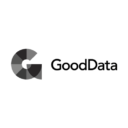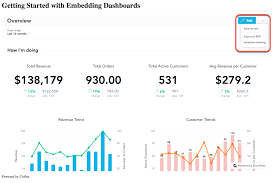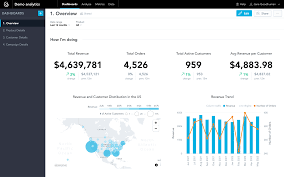Zoho Analytics, a robust business intelligence and analytics platform, plays a pivotal role in empowering businesses to unlock the full potential of their data. With its intuitive interface, powerful features, and comprehensive capabilities, Zoho Analytics enables users to analyze data, visualize trends, generate interactive reports, and derive actionable insights, ultimately contributing to business success. This article is designed to provide a deep dive into the realm of Zoho Analytics, exploring its key features, benefits, pricing options, use cases, and integration capabilities.

The GoodData platform allows users to connect to multiple data sources, whether they are stored in on-premises systems, cloud-based databases, or external applications. GoodData supports various data integration methods, including ETL (Extract, Transform, Load) processes, direct database connections, and API integrations.
- Robust GoodData Data Visualization: GoodData provides a comprehensive suite of data visualization tools, allowing users to create visually appealing GoodData dashboards and reports. These visualizations are customizable, interactive, and can be easily shared with stakeholders.
- Advanced GoodData Analytics: GoodData offers powerful analytics capabilities, including predictive analytics, machine learning, and AI-driven insights. These features enable businesses to identify trends, patterns, and opportunities hidden within their data.
- Seamless Data Integration: GoodData seamlessly integrates with various data sources, including databases, cloud storage, and third-party applications. This ensures that users can easily access and analyze all their data from a single platform.
- GoodData implementation: GoodData's platform is built to handle large volumes of data and support high user concurrency. It offers robust performance, ensuring fast and reliable data processing and analytics.
- Collaborative Environment: GoodData provides a collaborative environment where teams can work together on data analysis and reporting. Users can share insights, collaborate on
- Power BI:
Microsoft Power BI is a popular analytics tool known for its user-friendly interface and powerful capabilities. It offers seamless integration with various data sources, robust data visualization options, and advanced analytics features. Power BI also provides strong collaboration capabilities and is widely used by organizations of all sizes.
- QlikView:
QlikView is a leading data discovery and visualization platform that offers intuitive drag-and-drop functionality for creating interactive dashboards and reports. It provides robust data integration capabilities, associative data indexing, and powerful data exploration features. QlikView is known for its flexible deployment options and scalability.
- Looker:
Looker is a cloud-based data platform that focuses on data exploration, analytics, and collaboration. It offers a modern and intuitive interface for creating interactive dashboards and reports. Looker provides advanced data modeling capabilities and allows users to write custom SQL queries. It is particularly popular among data analysts and business intelligence teams.
- Domo:
Domo is an all-in-one cloud-based platform that combines data integration, analytics, and collaboration features. It offers a wide range of connectors to various data sources, powerful data visualization options, and advanced analytics capabilities. Domo is known for its ease of use and comprehensive solution for data-driven decision-making.
- Sisense:
Sisense is a robust business intelligence platform that enables users to easily prepare, analyze, and visualize complex data sets. It offers powerful data modeling capabilities, interactive dashboards, and advanced analytics features. Sisense is suitable for both small businesses and large enterprises, providing scalability and flexibility.
GoodData is suitable for businesses that require robust data analytics capabilities to gain insights from their data. It is commonly used by data-driven companies that want to leverage data to make informed business decisions, improve operational efficiency, and drive growth.
The platform is designed to accommodate users with varying technical skills, from business users and analysts to data scientists and developers. GoodData provides tools and features to transform raw data into meaningful visualizations, reports, and dashboards, enabling users to explore and analyze data effectively.
Additionally, GoodData offers features for data governance, security, and scalability, making it suitable for enterprises and organizations with large volumes of data and complex analytical needs.
- Professional Plan : Annual billing From $1000/month
- Enterprise Plan : Custom pricing
- Comprehensive Solution: GoodData offers a comprehensive analytics platform that covers all aspects of data analysis, from data integration to visualization and advanced analytics. This eliminates the need for multiple tools and simplifies the data analytics workflow.
- User-Friendly Interface: GoodData’s platform features an intuitive and user-friendly interface, making it accessible to users with varying levels of technical expertise. The drag-and-drop functionality and pre-built templates enable users to quickly create compelling dashboards and reports without extensive training.
- Scalability and Flexibility: GoodData is designed to scale with the growing needs of businesses. Whether you have a small team or a large enterprise, the platform can accommodate your data volumes and user requirements. It also provides flexibility in terms of data sources and customization options.
- Security and Compliance: GoodData prioritizes data security and compliance. The platform employs robust security measures to protect data and ensures compliance with industry standards and regulations, such as GDPR and HIPAA.

GoodData is a cloud-based business intelligence and analytics platform designed to empower organizations in making data-driven decisions. Offering a comprehensive suite of tools and features, it enables users to transform raw data into actionable insights. The platform facilitates the exploration, analysis, and visualization of data, providing users with effective means to derive value from their data.
One of the notable features of the GoodData platform is its capability to connect to multiple data sources, including on-premises systems, cloud-based databases, and external applications. This flexibility allows users to leverage data from diverse environments. GoodData supports various data integration methods, such as ETL (Extract, Transform, Load) processes, direct database connections, and API integrations. This ensures seamless connectivity and accessibility to relevant data for analysis and reporting.
- Features and Functionality:
Both GoodData and Tableau offer a wide range of features for data analysis and visualization. GoodData focuses on providing an end-to-end analytics platform with strong capabilities in data integration, advanced analytics, and collaborative reporting. Tableau, on the other hand, excels in its intuitive and interactive data visualization tools, allowing users to create visually stunning dashboards and reports.
- User-Friendliness:
Tableau is widely recognized for its user-friendly interface and drag-and-drop functionality, making it accessible to users with little to no technical expertise. GoodData, while still intuitive, may require a slightly steeper learning curve for users who are new to data analytics and reporting.
- Scalability and Performance:
Both platforms offer scalability and robust performance. GoodData is designed to handle large volumes of data and support high user concurrency. Tableau, on the other hand, provides excellent scalability and performance when it comes to data visualization and interactivity.
- Pricing:
Pricing is a crucial factor for many businesses. GoodData’s pricing is customizable and tailored to individual customer requirements, making it suitable for businesses of all sizes. Tableau offers different pricing tiers, including individual and enterprise plans, catering to various budgetary needs.
- Implementation and Integration:
GoodData provides seamless integration with various data sources and offers extensive support during the implementation process. Tableau also offers robust integration capabilities, allowing users to connect to multiple data sources. However, some users may find Tableau’s implementation process more complex compared to GoodData.
While GoodData and Tableau share similarities in their offerings, they also have distinct strengths. Tableau excels in data visualization and interactivity, while GoodData focuses on providing an end-to-end analytics solution with advanced analytics capabilities and collaborative reporting.
When considering GoodData or Tableau, it is essential to evaluate your specific business needs and requirements. Conducting a thorough analysis of your data analytics goals, user skill levels, and budget will help you make an informed decision about which platform is the best fit for your organization.
Mode Analytics, developed by Mode Analytics Inc., stands out as a robust analytics solution that empowers users to efficiently explore, analyze, and visualize data. This article aims to comprehensively explore various dimensions of Mode Analytics, encompassing crucial elements such as pricing, reviews, tutorials, dashboard capabilities, features, data visualization capabilities, the implementation process, available training options, a comparative analysis with Tableau, and insights into the download process.
Logi Analytics, a prominent embedded analytics platform, equips organizations with tools to create interactive dashboards, reports, and visualizations that facilitate informed decision-making. This article will delve into various facets of Logi Analytics, encompassing essential elements such as pricing, reviews, tutorials, dashboard capabilities, features, data analytics functionalities, the implementation process, available training options, a comparative analysis with Tableau, and insights into the download process.






